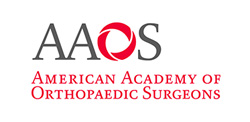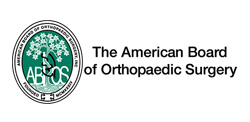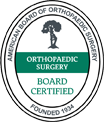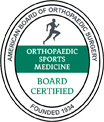Dr. Milan DiGiulio is an expert in Sports Medicine Physician and Surgeon, treating a variety of weekend warrior injuries, including advanced arthroscopic surgery of the Shoulder and Knee. Dr. DiGiulio performs over 200 successful arthroscopic shoulder and knee surgeries each year, using the latest medical technology. Dr. DiGiulio is an advocate of non-invasive, non-surgical treatment options with physical therapy and the use of biologics.
Sports injuries can occur in children, teenagers and adults when playing indoor or outdoor sports or while exercising. They can result from accidents, inadequate training, improper use of protective devices, or insufficient stretching or warm-up exercises. Dr. DiGiulio treats families for even the most common sports injuries, including sprains and strains, fractures and dislocations.
The most common treatment recommended for an injury is rest, ice, compression and elevation (RICE).
Some of the measures that are followed to prevent sports-related injuries include:
Shoulder Injuries
Pain in your shoulder while playing your favorite sport, such as tennis, basketball or golf may be caused by a torn ligament or tendon in your shoulder, even without having a specific injury. Overuse injuries from sports or exercise are a common cause of shoulder pain, and are often successfully treated with rest, anti-inflammatories, and a home exercise program. However, more persistent pain may be a sign of a more serious problem which might require an injection, physical therapy or surgical treatment.
Knee Injuries
The anterior cruciate ligament (ACL) is major stabilizing ligament in the knee, which may tear with over use while playing sports. The ACL has poor ability to heal and may cause instability. Other common sports injuries in the knee include cartilage damage and meniscal tear. Knee injuries during sports may require surgical intervention, which can be performed using open surgical or a minimally invasive technique. Your surgeon will recommend physical therapy to strengthen your muscles, and improve elasticity and movement of the bones and joints.
Sprains & Strains
Neck Strains and Sprains
The neck is the most flexible part of the spine and supports the weight of the head. The unique anatomical structure of the cervical vertebrae allows free movement of the head. The neck is also composed of muscles and ligaments. Any excessive stress on the ligament and muscles may injure or damage them.
A sprain is a ligament injury caused by over stretching the ligament beyond its optimal capacity. It may even result in a ligament tear.
A strain refers to damage to the muscle or its tendon when it is stretched beyond its capacity. In severe cases, it may even result in a muscle tear.
Some of the most common activities and movements that may cause a stress on the soft tissues of the neck include lack of adequate warm up exercises prior to the sports, a fall, awkward position of the neck during sleeping, poor posture and spearing in football. Motor vehicle accidents usually result in severe sprains and strains called whiplash injuries due to sudden unexpected movement of the neck.
Symptoms
A sprain or strain may result in neck pain, which may develop immediately after the injury or may present after a few hours or even days after the injury. The pain is usually intense and pounding in nature with a sudden onset. The pain may also radiate to the shoulder, upper back or arms. It may also be associated with muscle spasms. The affected region may be tender to touch with localized swelling and stiffness. Even slight movement of the neck can aggravate the pain. In rare cases, it may also result in loss of bowel or bladder function which is a medical emergency.
Whiplash injuries are more severe neck injuries. They usually result in headache, dizziness, jaw pain and a ringing sensation in the ears.
Diagnosis
An accurate diagnosis is crucial for effective treatment of this condition. To arrive at an accurate diagnosis the doctor will inquire about your symptoms, time of their appearance and a history of any treatments employed previously. A medical history, physical and neurological examination are also essential for diagnosis.
Neurological examination is conducted to identify any signs of neurological injury and involves evaluation of reflexes and muscle weakness. To confirm the diagnosis and to rule out other causes with similar symptoms an X-ray or a CT scan may also be performed. Rarely, an electromyography may also be ordered if an underlying muscle abnormality is suspected.
Treatment
Although the pain is excruciating, in a majority of cases non-operative therapies are sufficient. Some of the non-operative therapies include rest, activity modification, medications such as muscle relaxant and intermittent application of ice pack followed by moist heat application. A neck collar may also be recommended for a few weeks to support the neck as well as to prevent any neck movement in order to potentiate healing. Non-steroidal anti-inflammatory drugs or NSAID’s may also be prescribed to reduce the pain and swelling. Physical therapy, chiropractic or acupuncture may also be effective in some cases.
Acromioclavicular joint (AC joint) Dislocation
Acromioclavicular joint (AC joint) dislocation or shoulder separation is one of the most common injuries of the upper arm. It involves separation of the AC joint and injury to the ligaments that support the joint. The AC joint forms where the clavicle (collarbone) meets the shoulder blade (acromion).
Causes
It commonly occurs in athletic young patients and results from a fall directly onto the point of the shoulder. A mild shoulder separation is said to have occurred when there is AC ligament sprain that does not displace the collarbone. In more serious injury, the AC ligament tears and the coracoclavicular (CC) ligament sprains or tears slightly causing misalignment in the collarbone. In the most severe shoulder separation injury, both the AC and CC ligaments get torn and the AC joint is completely out of its position.
Symptoms
Symptoms of a separated shoulder may include shoulder pain, bruising or swelling, and limited shoulder movement.
Diagnosis
The diagnosis of shoulder separation is made through a medical history, a physical exam, and an X-ray.
Conservative treatment options
Conservative treatment options include rest, cold packs, medications, and physical therapy.
Surgery
Surgery may be an option if pain persists or if you have a severe separation.
Anatomic reconstruction
Of late, research has been focused on improving surgical techniques used to reconstruct the severely separated AC joint. The novel reconstruction technique that has been designed to reconstruct the AC joint in an anatomic manner is known as anatomic reconstruction. Anatomic reconstruction of the AC joint ensures static and safe fixation and stable joint functions. Nevertheless, a functional reconstruction is attempted through reconstruction of the ligaments. This technique is done through an arthroscopically assisted procedure. A small open incision will be made to place the graft.
This surgery involves replacement of the torn CC ligaments by utilizing allograft tissue. The graft tissue is placed at the precise location where the ligaments have torn and fixed using bio-compatible screws. The new ligaments gradually heal and help restore the normal anatomy of the shoulder.
Postoperative rehabilitation includes use of shoulder sling for 6 weeks followed by which physical therapy exercises should be done for 3 months. This helps restore movements and improve strength. You may return to sports only after 5-6 months after surgery.
Knee Dislocation
Patellar Dislocation
Patella (knee cap) is a protective bone attached to the quadriceps muscles of the thigh by quadriceps tendon. Patella attaches with the femur bone and forms a patellofemoral joint. Patella is protected by a ligament which secures the kneecap from gliding out and is called as medial patellofemoral ligament (MPFL).
Dislocation of the patella occurs when the patella moves out of the patellofemoral groove, (called as trochlea) onto a bony head of the femur. If the knee cap partially comes out of the groove, it is called as subluxation and if the kneecap completely comes out, it is called as dislocation (luxation). Patella dislocation is commonly observed in young athletes between 15 and 20 years and commonly affects women because of the wider pelvis creates lateral pull on the patella.
Some of the causes for patellar dislocation include direct blow or trauma, twisting of the knee while changing the direction, muscle contraction, and congenital defects. It also occurs when the MPFL is torn. The common symptoms include pain, tenderness, swelling around the knee joint, restricted movement of the knee, numbness below the knee, and discoloration of the area where the injury has occurred.
Your doctor will examine your knee and suggests diagnostic tests such as X-ray, CT scan, and MRI scan to confirm condition and provide treatment. There are non-surgical and surgical ways of treating patellofemoral dislocation.
Non-surgical or conservative treatment includes:
- PRICE (protection, rest, ice, compression, and elevation)
- Nonsteroidal anti-inflammatory drugs and analgesics to treat pain and swelling
- Braces or casts which will immobilize the knee and allows the MPF ligament to heal
- Footwear to control gait while walking or running and also decreases the pressure on the kneecap.
- Physical therapy is recommended which helps to control pain and swelling, prevent formation of scar of soft tissue, and also helps in collagen formation. Physiotherapist will extend your knee and applies direct lateral to medial pressure to the knee which helps in relocation. It includes straightening and strengthening exercises of the hip muscles and other exercises which will improve range of motion.
Surgical treatment is recommended for those individuals who have recurrent patella dislocation. Some of the surgical options include:
- Lateral-release - It is done to loosen or release the tight lateral ligaments that pull the kneecap from its groove which increases pressure on the cartilage and causes dislocation. In this procedure, the ligaments that tightly hold the kneecap are cut using an arthroscope.
- Medial patellofemoral ligament reconstruction - In this procedure, the torn MPF ligament is removed and reconstructed using grafting technique. Grafts are usually harvested from the hamstring tendons, located at the back of the knee and are fixed to the patella tendon using screws. The grafts are either taken from the same individuals (autograft) or from a donor (allograft). This procedure is also performed using an arthroscope.
- Tibia tubercle realignment or transfer - Tibia tubercle is a bony attachment below the patella tendon which sits on the tibia. In this procedure, the tibia tubercle is moved towards the center which is then held by two screws. The screws hold the bone in place and allow faster healing and prevent the patella to slide out of the groove. This procedure is also performed using an arthroscope.
After the surgery, your doctor will suggest you to use crutches for few weeks, prescribe medications to control pain and swelling, and recommend physical therapy which will help you to return to your sports activities at the earliest.
Sports Medicine Topics
Click on the topics below to find out more from the orthopaedic connection website ofAmerican Academy of Orthopaedic Surgeons.








